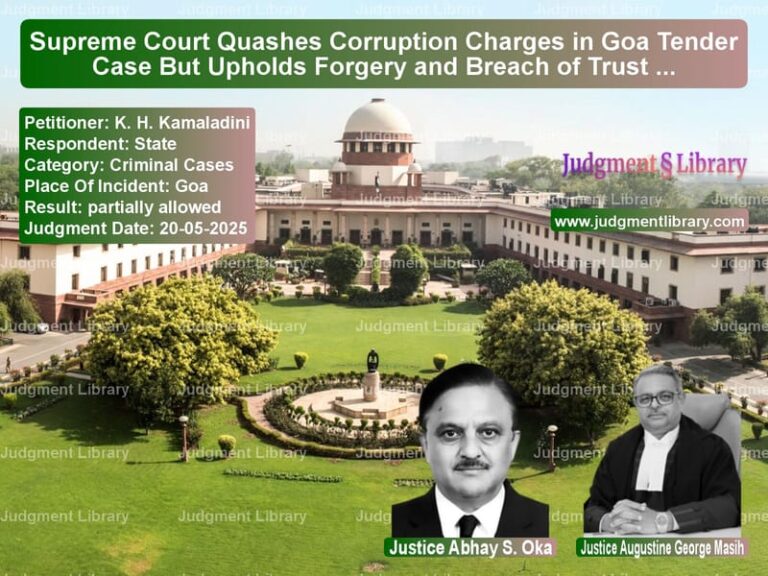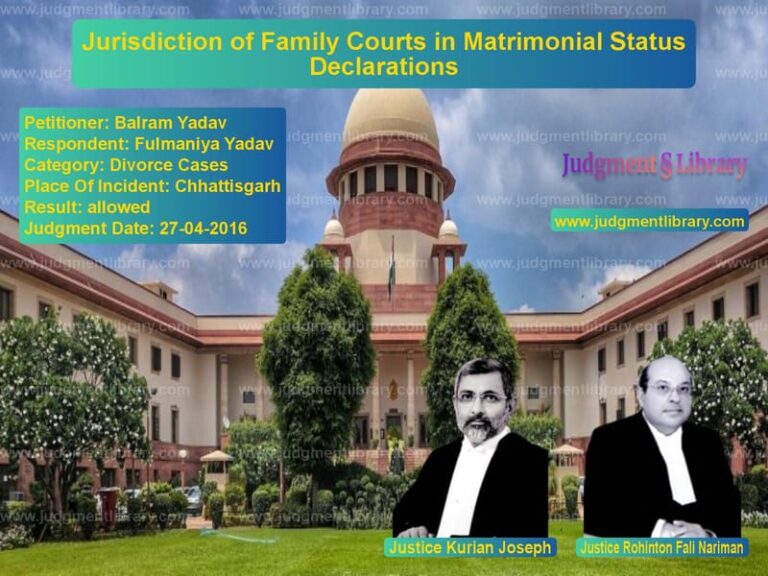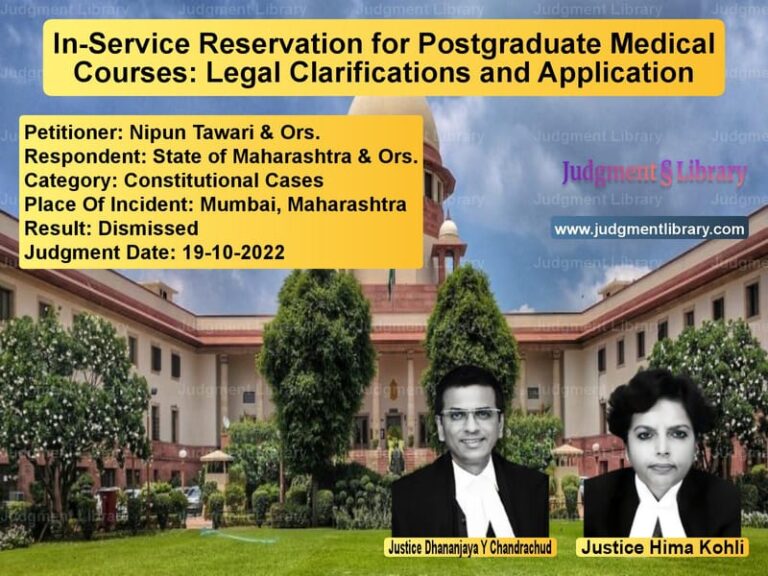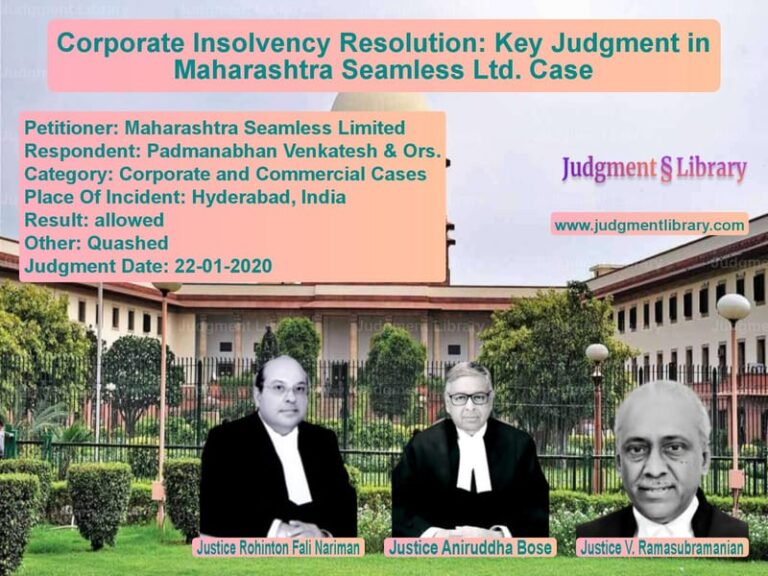Rakesh vs. State of Haryana: Supreme Court Modifies Sentence in Attempt to Murder Case
The case of Rakesh & Anr. vs. The State of Haryana is a significant criminal appeal regarding an attempt to murder under Section 307 IPC and related charges. The Supreme Court of India, in its judgment dated 10th October 2018, upheld the conviction of the appellants but reduced their sentence from seven years to five years considering mitigating factors.
Case Background
The case stemmed from an incident on 12th April 2000 in Haryana, where the appellants, Rakesh and Dalbir, attacked the complainant’s son, Raj Kishan, due to previous enmity between their families. The prosecution alleged that:
- Accused Rakesh inflicted a head injury on Raj Kishan using a “dang” (wooden staff).
- Accused Dalbir fired a gunshot at Raj Kishan’s neck.
- The attack was a result of a long-standing family dispute over an alleged abduction incident.
A case was registered, and both accused were tried under the following sections of the Indian Penal Code (IPC):
- Section 307 IPC (Attempt to Murder)
- Section 34 IPC (Acts done by several persons in furtherance of a common intention)
- Section 324 IPC (Voluntarily causing hurt by dangerous weapons)
- Section 323 IPC (Voluntarily causing hurt)
Dalbir was additionally charged under Section 25 of the Arms Act for possession and use of an illegal firearm.
Trial Court and High Court Proceedings
The Trial Court found both accused guilty and sentenced them as follows:
- Seven years’ rigorous imprisonment under Section 307 IPC
- Two years under Section 324 IPC
- One year under Section 323 IPC
- Two years for Dalbir under Section 25 of the Arms Act
Upon appeal, the Punjab and Haryana High Court upheld the convictions and sentences. Dissatisfied, the appellants approached the Supreme Court.
Arguments by the Petitioner (Rakesh & Dalbir)
The appellants contended that:
- The injuries were not life-threatening and did not justify a conviction under Section 307 IPC.
- The medical expert, Dr. G.P. Aggrawal (PW-12), stated that only one injury was caused by a firearm, which was not fatal.
- Their ages at the time of the incident (26 and 24 years) should be considered as mitigating factors for a reduced sentence.
Arguments by the Respondent (State of Haryana)
The prosecution, representing the State of Haryana, countered these claims, arguing that:
- The use of a firearm and the nature of the injuries demonstrated intent to kill, justifying a conviction under Section 307 IPC.
- The trial court and High Court had already reviewed the evidence, confirming the severity of the attack.
- The presence of a recovered firearm from Dalbir further established guilt under the Arms Act.
Supreme Court Judgment
The Supreme Court reviewed the evidence, particularly the testimony of the injured witness, Raj Kishan (PW-6), and the medical expert Dr. G.P. Aggrawal (PW-12). The Court made the following key observations:
- The use of a firearm and the injuries sustained justified the conviction under Section 307 IPC.
- Dr. Aggrawal’s testimony confirmed that injury No. 2 (gunshot wound) was dangerous to life, supporting the prosecution’s case.
- The presence of a recovered illegal firearm from Dalbir validated the Arms Act conviction.
Key Excerpts from the Judgment
The Court upheld the conviction but reduced the sentence, noting:
“The appellants were 26 and 24 years of age at the time of the occurrence, which was in the year 2000. Considering the facts and circumstances of the present case, the sentence of imprisonment imposed upon them is reduced to five years.”
Final Judgment
The Supreme Court modified the sentence as follows:
- Conviction under Section 307 IPC upheld, but the sentence was reduced from seven years to five years.
- All other convictions and sentences remained unchanged.
Legal Precedents and Significance
This judgment follows the principles established in previous rulings on attempt to murder cases, where the severity of injuries and the intent behind the act are crucial factors. The ruling highlights:
- The importance of medical evidence in determining the severity of injuries.
- That a firearm wound can justify a conviction under Section 307 IPC even if the victim survives.
- The Court’s consideration of the age of the accused as a factor in sentencing.
Conclusion
The case of Rakesh vs. State of Haryana reaffirms that convictions under Section 307 IPC require proof of both injury severity and intent to kill. The Supreme Court balanced legal principles with compassion, reducing the sentence considering the young age of the accused at the time of the offense.
Petitioner Name: Rakesh & Anr..Respondent Name: The State of Haryana.Judgment By: Justice R. Banumathi, Justice Indira Banerjee.Place Of Incident: Haryana.Judgment Date: 10-10-2018.
Don’t miss out on the full details! Download the complete judgment in PDF format below and gain valuable insights instantly!
Download Judgment: Rakesh & Anr. vs The State of Haryana Supreme Court of India Judgment Dated 10-10-2018.pdf
Direct Downlaod Judgment: Direct downlaod this Judgment
See all petitions in Attempt to Murder Cases
See all petitions in Bail and Anticipatory Bail
See all petitions in Judgment by R. Banumathi
See all petitions in Judgment by Indira Banerjee
See all petitions in partially allowed
See all petitions in Modified
See all petitions in supreme court of India judgments October 2018
See all petitions in 2018 judgments
See all posts in Criminal Cases Category
See all allowed petitions in Criminal Cases Category
See all Dismissed petitions in Criminal Cases Category
See all partially allowed petitions in Criminal Cases Category







